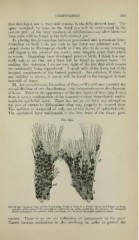Page 573 - My FlipBook
P. 573
OSSIFICATION. 583
first developed not a trace will remain in the fully-formed bone. The
space occupied by bone in the foetal jaw will be nerve-canal in the
mature jaw ; of the later products of calcification—say after birth—at
least some will be found in the fully-formed jaw.
In placing the division-line between provisional and permanent bone-
formation at birth I do not wish to lay down any arbitrary rule. I
simply desire to illustrate as clearly as I am able to do so my meaning,
and impart to the mind of the reader some tangible point from which
to reason. Regarding bone developed prior to birth, I think it is per-
fectly safe to say that not a trace will be found in mature bone. In
making this statement I do not lose sight of the fact that adult tissues
are continually being reprodu(;ed. I speak only of the form, not of the
integral constituents of the formed material. Xevertheless, if there is
any stability in tissues, it .surely will be found in the inorganic formed
material of bones.
II. IntrcuneinhrdnoHs Formation of Bone.—We \yill now consider the
second division of our classification— viz. intrainenibra)Lom development
of bone. Prior to the apj)earance of the first layers of bone (pig 4 cm.)
there is seen a condensation of the connective tissue innnediately under-
neath the epithelial layer. There has not as yet been any attempt on
the part of nature to differentiate what may properly be termed skin.
The epiljlast is composed of only one or two layers of epithelial cells.
The condensed layer underneath is the first trace of the future peri-
FiG. 323.
Part of the Growing Edge of the Developing Parietid l^one of a Foetal Cat (1^ inch long): .sp, bony
spicules, with some of the osteoblasts embedded in them, producing the lacunae; o/, osteogenic
fibres prolonging the spicules, with osteoblasts (out) between them and applied to them.
osteum. There is as yet no indication of perio.steum in the jaws.
Nature hastens ossification in the skull-caj) in order to protect the


